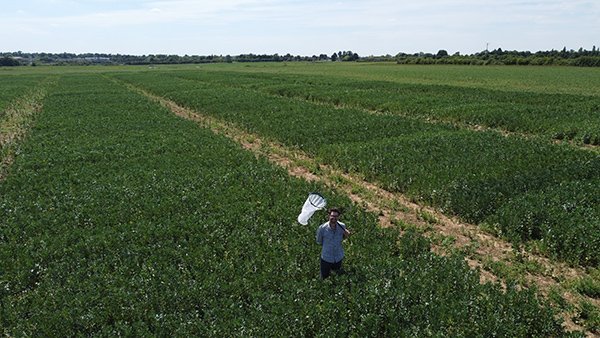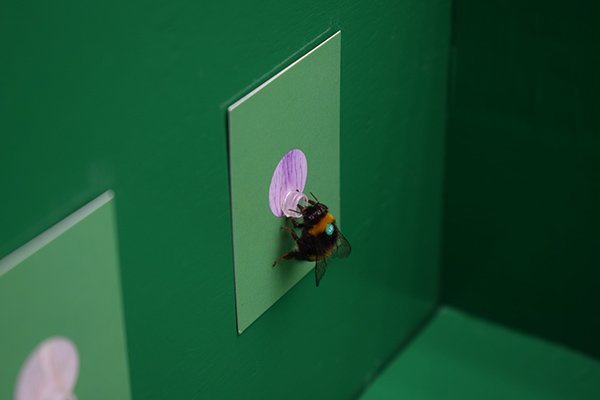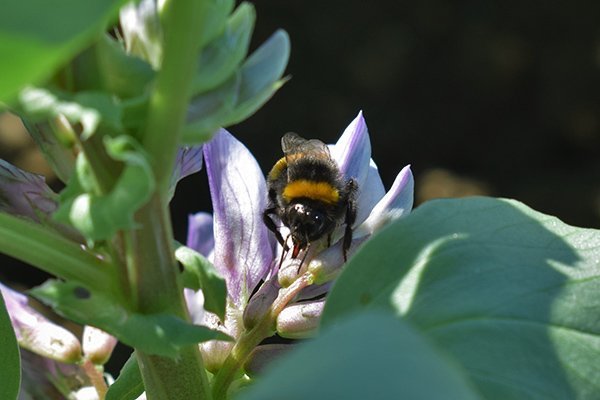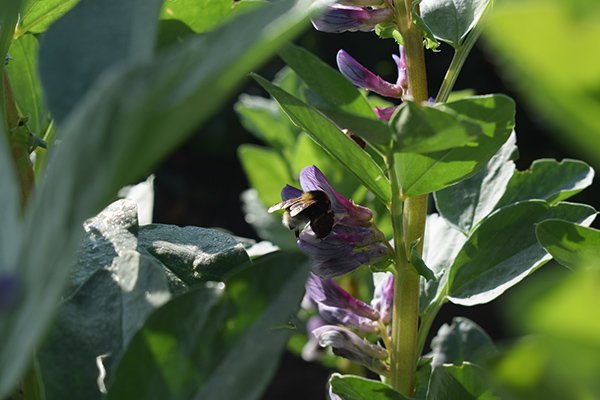Strategies to optimise pollination of the UK field bean crop
PhD (BBSRC iCASE/ PGRO/ Cambridge University):
The PhD seeks to explore strategies to maximise pollination in field beans using breeding for flower characteristics.
Pollination is an essential part of the production of our food supply, with approximately one third of our food resulting from animal insect pollination. Ensuring an adequate supply of pollinators is essential to maintain global food security. However, pollinator populations have declined in many parts of the world, and it is likely that climate change will further uncouple relationships between plants and insects.
Field beans are used as animal feed, providing an important protein supply because they fix nitrogen. Recent reports suggest that pollination service is limiting yields in field beans.
The project will explore strategies for optimising field bean flowers to provide maximum energetic reward to pollinators for minimum foraging energy expenditure. This will have the dual benefit of increasing pollinator attraction to current crops, thus increasing yield, while also supporting wild pollinator populations, thus increasing future pollinator population sizes (and thus future yield).
Using a combination of analytical, molecular genetic and behavioural ecology techniques to explore strategies to enhance pollination, commercially grown line will be screened for variation in pollinator-relevant traits to identify genetic variation of potential use in breeding programmes.
Molecular genetic approaches will be used to explore the development of key traits. Using caged bumblebee facilities variations we identify will be assessed for influence on pollinator behaviour. Any lines that appear to attract additional pollinators or facilitate pollinator handling will be trialed in greenhouses with enclosed bumblebee colonies, to assess the effects on pod and seed set.
Such lines will then be tested in field conditions at PGRO’s field trails sites, to explore yield under natural conditions and to develop strategies for future selective breeding of the UK field bean crop.
Background
Vicia faba is an important legume crop in the UK, valued for its high protein content and ability to fix nitrogen. Faba beans are likely to be increasingly important as a less environmentally harmful protein source, however, without insect pollination, faba bean yield is lower by 32.9% on average. With continuing declines in bee populations, it is imperative that we understand how floral traits of V. faba affect pollination of the crop, both to be able to enhance flower attractiveness and reward for pollinators, and to ensure more stable yield.
Aims of the research
My PhD research over the last four years has sought to identify previously unexplored variation in floral features of faba bean lines, test the effect of V. faba floral trait variation on bee attraction in field conditions, and study whether increased bee visitation due to floral trait differences can enhance V. faba yield. My research has also investigated which floral traits are likely to be most important in bee attraction. The goal of this research has been to gather information that will be useful to growers and breeders in the future when further bee declines are likely to affect yield stability.
Findings
In this project, substantial variation has been identified between lines of V. faba in flower morphology, nectar volume and concentration, pollen production, flower colour and patterning, flower operative force, and the number of flowers produced by plants. In summary, the line Maris Bead has the highest nectar sugar content per flower (49.00 % weight by weight), alongside Vertigo (42.03 %) and Lynx (39.3 %). Tundra has the largest number of flowers per node on average (9.4), alongside Fuego (7.6), Tiffany, Fanfare, LG cartouche and Maris Bead (all 7.5). Maris Bead has the most intensely coloured purple flowers, in contrast to most other lines which have white flowers with varying degrees of pink colouration. These results suggest that some lines provide more floral resources and may be more attractive to bees than others. Therefore, I hypothesised that lines which score highly for the floral traits studied should attract more bees than those which score poorly.
When selected V. faba lines showing extremes of floral trait variation were grown in field trials, bees present in the environment showed preference for lines with more flowers and superior nectar sugar content, particularly the lines Maris Bead and Lynx. Bees showed consistency in preference between years (2021 and 2022) and location (Lincolnshire and Cambridgeshire). In general, carder bees and white-tailed bumblebees have greater potential as pollinators of the crop, as they perform more “legitimate” flower visits, entering the front of the flower. However, red tailed bumblebees and honeybees may be less effective pollinators, as they perform more “nectar-robbing”, chewing holes in the flower to remove nectar, and visit extra-floral nectaries on the plant stipules.
Field trails included a yield comparison component to test the effect of pollinator exclusion on yield of the different lines compared. Exclusion of insect pollinators had a negative effect on faba bean yield compared to open pollination for most lines tested in both 2021 and 2022. However, the size of yield difference differed greatly between lines. The largest yield difference between open pollination and pollinator exclusion was for Maris Bead in 2022 (79.5 %), Yukon in 2022 (53.6 %) and Tiffany in 2022 (39.1 %). A significant positive relationship was found between the number of bees visiting lines and the yield benefit of those lines when open pollination compared to pollinator exclusion. This is the first study to demonstrate that differences in floral traits can influence the attraction of bees to V. faba in field conditions, and that differences in bee visitation due to floral traits can have a significant positive impact on yield.
Following field trials, the effect of specific floral traits on bee behaviour was examined in controlled conditions to assess the relative importance of traits for bee preference. Several experiments were performed to examine bee behaviour in response to differences in standard petal appearance and colour, wing petal spot size, and flower scent.
In controlled conditions Bombus terrestris worker bees showed innate preference for models representing standard petals of the V. faba line Maris Bead over those representing NV129. Similarly, they showed innate preference for models representing standard petal vein colour of the V. faba line Maris Bead (purple) over those representing NV129 (yellow). B. terrestris workers also showed preference for the scent of Maris Bead flowers over those of NV129. Together these results suggest that colour and scent may provide strong foraging cues when B. terrestris workers forage on V. faba flowers and partly explain the bee preferences observed in the field. B. terrestris workers also showed ability to distinguish between extremes of trait variation for petal background colour and wing petal spot size, suggesting that these traits can influence bee behaviour, when paired with a good nectar reward.
Conclusions
This study has increased knowledge of floral trait variation in previously uncharacterised V. faba lines and has demonstrated for the first time, that differences in floral traits can influence bee attraction and affect yield. This research has identified flower colour, nectar content, flower number, and scent as promising floral traits which should be explored further to enhance pollinator visitation to V. faba crops. The information gathered by this study can be used by farmers to grow lines which better support wild pollinators and are likely to have stable yield in environments where pollinators are present. Equally, this information provides a starting point for breeders to consider floral traits as a means of improving yield and developing lines which are more beneficial and attractive to bees.
It is clear that the future of agriculture needs to work more closely with nature, in contrast to industrial methods which degrade the environment. This mindset should be applied not only to the techniques we use, but also the crops we grow. By making use of Vicia faba floral traits we can better support pollinators, ensure good pollination of the crop, and produce more sustainable food.




The full thesis can be accessed here >
Sponsors:

Cambridge University BBSRC DTP iCASE Studentship and Processors and Growers Research Organisation (PGRO)

Student:
Jake Moscrop -
Start Date: October 2018
Duration of study: 4 years



